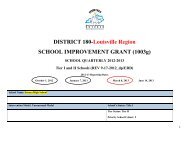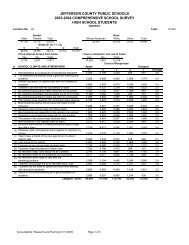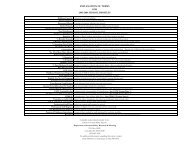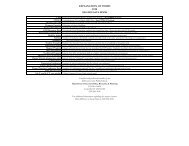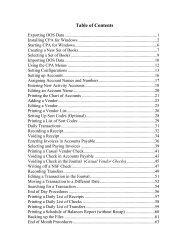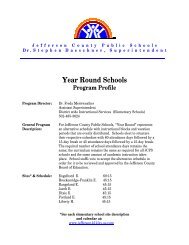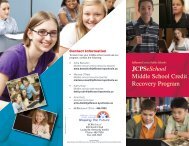exceptional child education - Jefferson County Public Schools
exceptional child education - Jefferson County Public Schools
exceptional child education - Jefferson County Public Schools
You also want an ePaper? Increase the reach of your titles
YUMPU automatically turns print PDFs into web optimized ePapers that Google loves.
elated services should only be considered after appropriate interventions have been implemented as<br />
described in this section.<br />
SECTION IV<br />
REFERRAL SYSTEM<br />
The LEA shall have a referral system that explains how referrals from district or non-district sources will be accepted<br />
and acted upon in a timely manner. 707 KAR 1:300, Section 3(1)<br />
If a <strong>child</strong> or youth is identified as having a suspected disability, the referral source, including but not<br />
limited to teachers, parents, and professionals, completes a written referral.<br />
If a parent or an individual who is not employed by the district refers a <strong>child</strong> or youth, district<br />
personnel (e.g., school counselor, building principal, teacher) provide assistance to make sure that<br />
the written referral document is completed and submitted to the ARC chairperson/district<br />
representative within fifteen (15) school days after the individual initiates the referral.<br />
The completed written referral includes:<br />
A. Personally identifiable data, including name, parent, address, date of birth, and student<br />
number or social security number;<br />
B. Current screenings in the areas of communication, hearing, and vision and the results of<br />
any follow-up evaluations if applicable;<br />
C. An <strong>education</strong>al history, including, but not limited to, school(s) attended, patterns of<br />
attendance, years in school, current grade placement, grades, and participation in<br />
<strong>education</strong>al/behavioral support programs;<br />
D. A written description of the current status of the <strong>child</strong> or youth in relation to his or her<br />
similar-age peers in such areas as communication, academic performance, or<br />
developmental skills; health, hearing, vision, and motor abilities; social and emotional<br />
competence; and general intelligence;<br />
E. Results of performance on districtwide and state-mandated assessments and existing<br />
screenings collected according to the district procedures for screening to identify mentalhealth<br />
barriers to learning;<br />
F. A listing of the <strong>child</strong>’s or youth’s involvement with outside agencies; and<br />
G. A written summary of appropriate instruction, support services, and interventions that<br />
have been provided in the regular <strong>education</strong> program/environment to address each area of<br />
concern and to improve the <strong>education</strong>al performance or behavior of the <strong>child</strong> or youth.<br />
See Section III, “Coordinated Early Intervening System” in this chapter. This written<br />
summary should include the following:<br />
1. The areas of <strong>education</strong>al performance or behavior targeted for intervention(s);<br />
2. Specific intervention(s) used (e.g., support services, strategies, methods, materials,<br />
environmental changes);<br />
3. The length of time the intervention(s) were implemented;<br />
4. Personnel involved in the intervention(s); and<br />
5. The impact of the intervention(s) on the problem.<br />
6 3: Child Find, Eval, & Reeval




